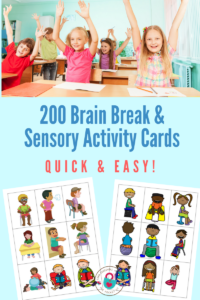Many children are exhausted by the daily routines of life and school. Often in my conferences, parents ask me why their child experiences a total meltdown as soon as they get into the car or home. My own son experiences this and I understand the frustration for both the child and the parent. While there are many explanations for this, a common one is dyspraxia. It’s a developmental disorder in the way our brains process information. Dyspraxia affects the planning of activities. So, there is difficulty forming a plan and then carrying it out. This is actually more common than we might think. Here’s the link to the dyspraxia USA foundation. It often co-exists (comes along with other disorders such as sensory processing disorder, learning disorders, and ADD/ADHD). Dyspraxia is an ‘invisible disability’ where children look the same as their peers so they are expected to perform at the same level.
What are the signs and symptoms of dyspraxia?
- Many children have decreased tone in the muscles – they can slouch or ‘W-sit’ to gain stability in their bodies.
- Can have trouble with fine motor tasks (buttoning, writing, tying) and gross motor tasks (skipping, hopping, jumping rope, kicking a ball, and even climbing playground equipment).
- Children with dyspraxia are often labeled as ‘clumsy’ or uncoordinated.
- They often crash or bump into things and stumble.
- Sometimes children even appear ‘messy’ or disorganized as their buttons may be crooked, their pants may be askew, they spill often.
Muscle tone can affect any motor task and children may even look as though they are slumping or even falling out of their seats in school. It can be extremely frustrating to keep up with the demands of school – especially as the children get into higher grades. As a result, self-esteem and social skills difficulties occur and compound the problem. Some children develop compensatory strategies which can help up until a skill becomes increasingly difficult.
What do I look for in my child?
-difficulty self-feeding
-trouble crawling and meeting gross motor developmental milestones
-core muscle weakness or difficulty sitting upright without support
-trouble adjusting clothing properly
-tired hands
-difficulty riding a tricycle or bike
-problems establishing a routine and seem to need more ‘adult’ help than peers
-difficulty catching, tossing, kicking a ball
-coloring and holding writing utensils and scissors
-complaining of sore muscles in the neck and back
Children are often aware that they are not able to keep up with peers. The best thing to do is to talk about frustration and look for physiological signs of stress such as a red face, not interacting with peers in social situations, stomach aches after social events and school, and increases in heart rate and negative behavior.
What to do to help your child? It’s best to discuss any developmental concerns with your child’s physician. DO NOT let anyone brush you off or tell you, ‘it’s because he’s a boy’ or ‘you worry too much.’ Parents are the best advocates for their children. Practice activities such as crossing midline and fine motor skills.
Here are two videos I made that are packed with activities: Click to access the videos Brain and sensory activity cards…..each card has instructions and can be used in the home, school, and therapy clinic!
Speak with an occupational therapist about ways to increase muscle strength. Remember that dyspraxia involves forming a plan. One of the ways to help children is to involve as many senses as possible. So, when learning letters…..write them with sidewalk chalk and walk on them. Use magnetic letters, trace letters with sandpaper, and draw letters with large body movements involving the whole arm. Read our previous blog post
here on learning through movement and this one on activities for children that are fun and build skills.





